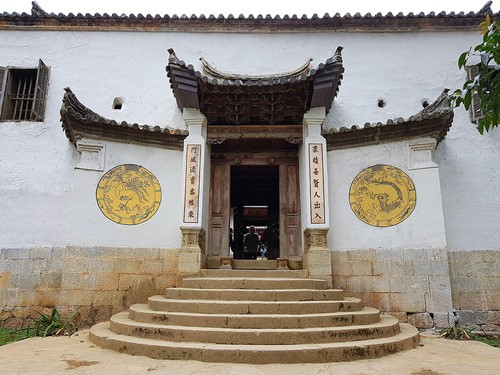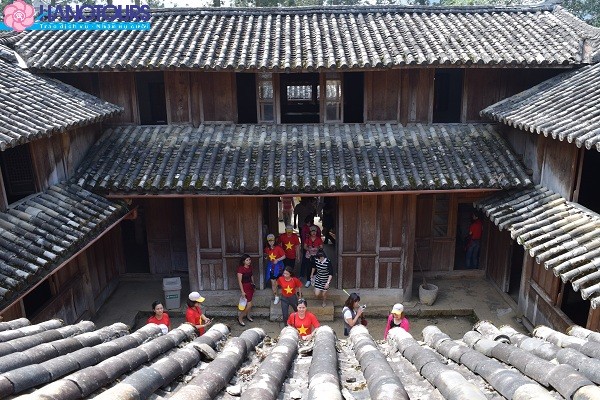(VOVWORLD) - Vuong Chinh Duc is honored as the king of the Mong or Meo ethnic minority group in Ha Giang province. His house is the largest structure in the locality and boasts a special architectural style. The Mong King’s Palace was recognized as a national relic in 1993.
Vuong Chinh Duc once ruled Quan Ba, Yen Ninh, Meo Vac, and Dong Van district. A century ago, he hired Chinese builders and tens of thousands of Vietnamese in building the palace. He spent an enormous large amount of money on the construction. The labor cost alone was so high at 6,500 USD that it set a temporary record for Ha Giang.
 The entrance gate to the Mong King's palace. (Photo: baovanhoa.vn) The entrance gate to the Mong King's palace. (Photo: baovanhoa.vn) |
Vuong Thi Cho, a member of the Vuong family and a tour guide at the palace, said: “Mr. Duc, whose ethnic name is Vang Giong Lung, was born in 1865 and died in 1947 at the age of 82. His tomb is on the back of the mountain, 3 kilometers from the palace.
"Mr. Duc had three sons, but his second son, Vuong Chi Sinh, was best known by the locals. He was a sworn brother of President Ho Chi Minh, a deputy of the 1st and 2nd National Assembly, and the first Chairman of Dong Van district’s People’s Committee.”
Seen from above, the Vuong family’s palace looks like a tortoise shell in the middle of the Sa Phin valley. The 3,000-square-meter complex is flanked by an arc of mountain range, making it a fortress. Embracing typical Mong ethnic architecture with influences from China and France, the two-storey, 50-meter-long building demonstrates its owner’s wealth. Outside the palace are two defensive blockhouses and the tombs of Mr. Duc’s offspring. Inside the palace, there is an arsenal, a treasury, a drug store, residence rooms, offices, a kitchen, and animal farms. The complex is embellished by surrounding fruit orchards and flowers. The delicate decorations carved into the stone and wood symbolize prosperity.
“Construction of the Mong King’s palace started in 1989 and was completed in 1903. There are 64 rooms, related to the 64 feng shui bagua cards. The house is divided into three chambers: the front chamber for security guards, the central chamber for Mr. Duc’s wives and children, and the rear chamber for him. The palace was restored in 2004. All the walls and tile roofs remain intact. 40% of the original pine wood was replaced by iron wood,” said Cho.
 (Photo: baovanhoa.vn) (Photo: baovanhoa.vn) |
The palace welcomes a large number of Vietnamese and foreign tourists every day.
“I enjoyed the history a lot. The tour guide here provided a great inside into the history of the architecture and different influences of the architecture. I think it’s the most interesting aspect. I think probably the architecture is my favorite of the palace itself. Touring around has been very insightful. We learned a lot about the history of the country and the ethnic group here. We had a great time,” said Ben Brenner from California, the US, who visits the Mong King’s palace for the first time.